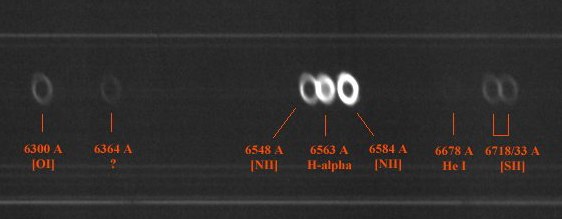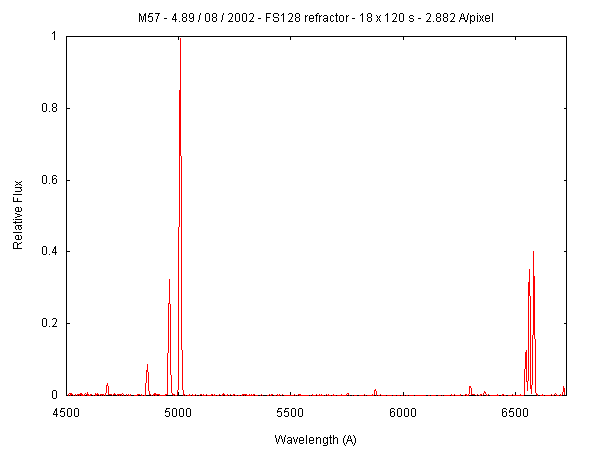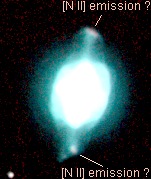
SPECTROSCOPY OF PLANETARY NEBULAE
M57 (part one)
M57 (part two)
NGC 7662
NGC6826
NGC7009
Slitless high resolution observation of the famous Messier 57.
The spectrum of nebula M57 in the
vicinity of line Ha captured Aug'99 with at the resolution of 3000 approximately (Flat-Field
camera of 190-mm). Sampling is of 0.93 A/pixel. Co-adding of 17 images,
120 seconds exposures each. This document shows that line Ha is not the only source of light
in this area of the planetary nebula spectra. This one is surrounded by the
lines [NII], which still are more intense. The line at 6364 angstroms is [OI].
For a peculiar processing description of this image, click here.


2D spectrum of M57 for the green
(negative view). Note the small size of the nebula at 4686 angstroms He II line
(only the central part emit at this wavelength):

Commented 2D spectrum of M57 (exposure: 18 x 120 seconds
- Instrument: Takahashi FS128 refractor (5-inch aperture) + 2.88 A/pixel slit spectrograph + Audine CCD camera
Kodak KAF-0401E) : this spectrum show lines of my light-polluted site (yellow),
airglow lines of the atmosphere (green) and M57's lines (red). For detail related
to the night sky spectrum, click
here. Note change of morphology of the nebulae
relative to the spectral line. Note also the simultaneous [OI] 6300 A presence
in the terrestrial atmosphere and in M57 :

The 2D spectrum after removing the sky background (L_SKY3 command of Iris software):

The spectral profile extracted from the 2D spectrum above:


Localization of the entrance slit of the spectrograph (zero order image):

Slitless 2D spectrum of M57 with the same instrument. Note the broadening of the high-pressure sodium and mercury street lamp lines and the blend of the M57 lines (i.e. lower spectral resolution):

The 2D spectrum (large slit - red is right):

Narrow slit spectrum profile:
Le
spectre en deux dimensions de NGC 7009 (le rouge est à droite) :

Ci-après,
la région de la raie rouge de l'hydrogène fortement agrandie. Malgré la faible
résolution spatiale on note que l'émission de l'azote interdite ionisé [N II] est
très localisée par rapport aux autres raies. L'axe perpendiculaire à la dispersion
est orientée suivant les ascensions droite.
Ci-dessous une image en couleurs de la nébuleuse NGC7009 orientée conformément
au spectre. Document réalisé par François Colas au T1M du Pic du Midi et avec
un appareil photographique numérique Canon
EOS 10D. Il est possible que les faibles émissions rougeâtre soient dues
à l'azote.